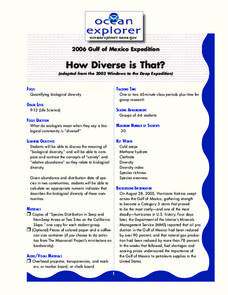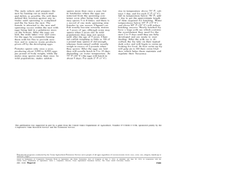Curated OER
Pseudogene Suite
Students use Biology Workbench to explore DNA sequence data for the GULOP gene in humans, chimpanzees, orangutans, and crab-eating macaques and the beta globin gene and its pseduogene in humans, gorillas, and chimpanzees.
Curated OER
Cell Pizza
Students identify parts and functions of microscope. Students watch video, Cells and Life about cell parts with actual pictures and actual cells. Students discuss video and identify parts of the cells that animals and plants have in...
Curated OER
Patterns of Heredity
A family tree of dogs guides students through this activity, in which students analyze the pedigree. With a key describing the genetic attributes (tall dominant, short recessive, or male/female), students complete five questions about...
Curated OER
Human Heredity Vocabulary
Ninth graders review the terms "aneuploidy," "fetus," and "karyotype" in this vocabulary worksheet, which includes three multiple choice questions about each term. This activity could be expanded into a more developed vocabulary lesson...
Curated OER
Animals and Plants of BC's Rocky Shore
Students fill out a fact sheet and look at diagrams of BC's shore and the animals that live there. In this habitat lesson plan, students discuss the plants and animals and the different zones they live in.
Curated OER
Draw an Alien in Natural Habitat
Students apply prior knowledge of living things, structures of living things and how living things sense and respond to their environment. In this habitat lesson, students review the basic needs of organisms to survive. Students create...
Curated OER
Pair the Plants: An Introduction to Scientific Names
Students examine why plants have both common and scientific names, then complete the activity by matching each common plant name with its scientific name. They finish by working in cooperative groups to create an ABC of Plants class book.
Curated OER
Community Cell
Students explore parts and functions of the cell, and create models of assigned organelles.
Curated OER
How Diverse is That?
Students discuss biological diversity in ocean communities. In this diversity lesson, students examine the variety of organisms compared to relative abundance. They will write an analysis and discuss their findings with the class.
Curated OER
Biospheres in Your Backyard
Students collect data from a local river biome. They use the information for metric conversion and graphing equations. They study the components of what makes up a biosphere and how math is used to analyze one.
Curated OER
Teaching Biology Through Problem-based Activities
Students plant seeds and observe the life cycle of the organism. They experimentally research the effects of radiation on seed growth. Students determine the effects of environmental pollutants on harvested seed.
Curated OER
Habitat Unit - Day 2
Learners explore abiotic factors that affect habitats. After a class lecture, students work in groups to answer questions about plant tissue, production and growth. They share answers, complete a crossword puzzle, and create a habitat...
Curated OER
Lesson 3: Understanding Population Growth
Students explain population growth in Maryland and its relationship with age structure, household growth and consumption of land.
Curated OER
Fisheries Project
Students explore biology by completing a fishing worksheet. For this commercial fishery lesson, students identify the process of taking mass fish from the ocean and delivering them to eateries while discussing the negative aspects....
Curated OER
Disease and Epidemics
High schoolers explore how the study of diseases, epidemics and disease management offers opportunities for exploration of biological evolution, immune systems, interaction between humans and their environment, and interaction among...
Curated OER
What's Happening to Your Body
Students list the types of biological development that occur during adolescence and the nutritional, physical, and mental needs that support that development. They describe careers in the field of adolescent health.
Curated OER
Toxicology and Living Systems
Learners investigate how toxic chemicals affect biological systems. They determine the toxic dose of a chemical that inhibits seed germination in a Brassica rapa. They investigate the effect of environmental tobacco smoke on human lung...
Curated OER
Channel Catfish
Students study the life and biology of the Channel Catfish. In this aquatic biology lesson, students will examine the external and internal features of the catfish along with their breeding habits and environment. This lesson includes...
Curated OER
Red Mangroves Of Southern Florida
Students engage in a unit plan to examine the ecological background for the Mangroves of southern Florida. They conduct research using print and computer technology sources. They use the information in a number of other extension...
Curated OER
Lesson 18, My Friend Linda
Students explore Huntington's Disease. In this biology lesson, students read My Friend Linda and examine the ethical issues brought to light in the story. Students discuss biotechnology issues and genetic testing.
Curated OER
Stages of Fetal Development
Tenth graders gain a better understanding of the biological processes of a fetus. They study step by step what occurs during a pregnancy.
Curated OER
The Environment and Interactions of Living Organisms
Students study the environment and interactions of living organisms. They identify abiotic and biotic factors and create a foldable and vocabulary cards. They create a poster illustrating soil and watch a video to study symbiosis.
Curated OER
Why Cladistics?
Students explore how biological classification is intimately associated with evolution.
Curated OER
Let's Hit the Slopes!
Students study benthic communities in the Gulf of Mexico and explain their roles. In this investigative lesson students participate in a group activity and study how to calculate and index of biological communities.

























